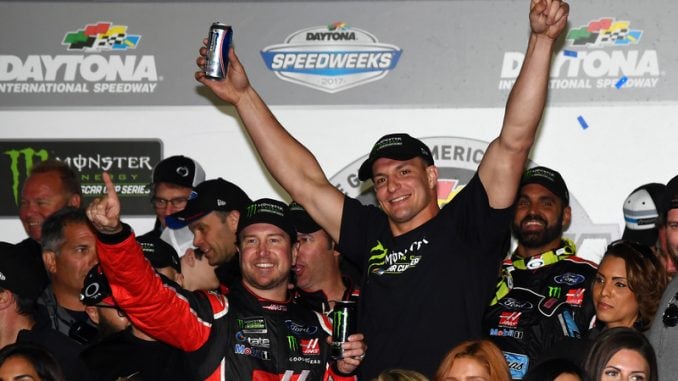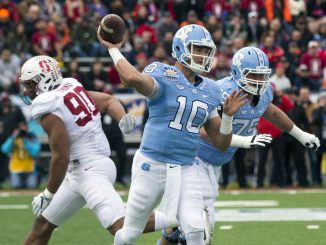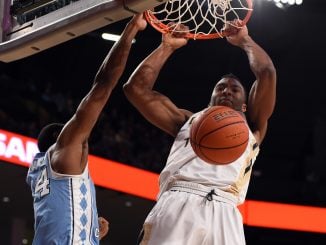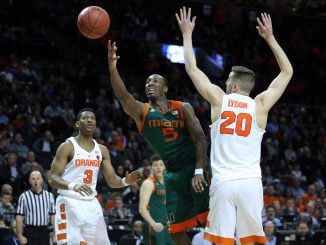
A funny thing happened on Sunday down the stretch at Daytona: amid a sea of youth, an old man emerged to steal the checkered flag. Kurt Busch’s victory, amid big-name wreckage and a sea of rules changes, offered a reminder about the value of experience on the fastest of tracks.Chase Elliott held the lead in a single-file draft before running out of gas with three laps remaining. Kyle Larson then took over the lead, only to lose it to Busch after his tank ran dry as well. Busch wan’t home free, however, having to battle off Ryan Blaney down the stretch to steal his first Daytona 500 victory.Busch is clearly the elder statesman of the group, having won at the track for the first time at age 38, after his 17th attempt. But the other three drivers in that equation are all 24 years old or younger, with Elliott and Blaney in their second seasons.It’s an all-too-common issue for the young guns in the sport: experience trumps everything else. Busch alluded to that following his Daytona 500 triumph.”I was seeing all these young guys, all these new guys,” Busch explained, “I’m like, ‘Aha, I’m the old bull here. I’ve just got to take my time.'”Larson finally pulled one off last season in his third year at Michigan, but no other driver to start in the last six years has collected a regulation win. Chris Buescher won a fog-shortened race at Pocono last year, but that was more luck than skill. Trevor Bayne was the last to win a race before that, but it was a one-off victory with Wood Brothers Racing in the 2011 Daytona 500.”I can count all the races they’ve won on one hand,” Kevin Harvick said of the young drivers in the sport. “All of them. I feel pretty good about where I’m at.”Busch prevailing was simply more proof that the up-and-coming drivers still haven’t quite caught up with the old guard. Guys like Elliott, Larson and Blaney might be in contention when the NASCAR playoffs roll around, but wins are the quickest way to a championship.Perfect situation for SHR, Ford and MonsterSunday was looking like a horrendous day for Ford’s new super team in Stewart-Haas Racing. Harvick was three laps down despite winning the second stage of the race. Both Danica Patrick and Clint Bowyer were involved in the same wreck and sitting in the garage.The last hope was Busch. He pulled through when the team needed it the most. And with Monster Energy the new title sponsor for the premier series on his hood, it was an ideal scenario for everyone involved with Busch.”I tried not to put any extra pressure on my shoulders,” Busch said. “I tried to rely on my team’s strengths and not focus on what I have been through with Monster Energy the last six years. They are a strong, big company and they have chosen to be the entitlement sponsor and I can’t be happier to do the job I am supposed to do as a Monster athlete, which is to win podiums and races.”Here we are. We are with the Daytona 500 trophy.”Stewart-Haas has been through a lot of changes in the last year with the move to Ford, retirement of Tony Stewart and Nature’s Bakery leaving Patrick without a primary sponsor. Sunday was a retreat from the lawsuits and tempestuous times in the SHR garage.”It has been a really long, hard winter, and I am so proud of everyone at SHR and Ford Performance,” said Stewart. “… Had I known that all I had to do was retire [to win the Daytona 500], I would have retired 17 years ago.”Rookie MistakesWhile several second and fourth-year drivers found success at Daytona, it was a day to forget for nearly every rookie driver.Daniel Suarez and Erik Jones came into the season as the two rookies to watch with one driving for Joe Gibbs Racing and the other with a partnership with the super team. When both had issues on an all-Toyota pit stop during the first stage Suarez going too fast and Jones missing his pit box Toyota’s strategy completely fell apart.It wasn’t just Suarez and Jones making mistakes, though, with Corey LaJoie making countless bloopers to start the race. The BK Racing rookie locked up his brakes attempting to enter pit road and smashed into the wall. He then missed his pit box while trying to get the damage fixed just 26 laps into the race.Ty Dillon, the lone rookie not in a Toyota, was actually having a solid afternoon before Kyle Busch wrecked ahead of him and Jamie McMurray ultimately cost him a chance to finish. Dillon spent much of the afternoon in the top 10, but finished 30th due to multiple huge wrecks.Daytona likely won’t be the only time the rookies will make mistakes, but it was a sobering season opener for the heralded class.Drivers who stick together, wreck togetherSo, let’s talk about that Toyota strategy a little more.Joe Gibbs Racing and Furniture Row Racing teamed up to outwit the competition and win the first two stages. It paid off for Kyle Busch initially as he won the opening stage. It then backfired as Kyle spun out, collecting Jones and Matt Kenseth in his wake.With so much attention on the six cars for JGR and Furniture Row, none of them finished inside the top 10 while four finished in the garage. In fact, the highest finishing Toyota in the stable was Michael Waltrip, who came away with an eighth-place result in his final start with Premium Motorsports.Toyota has often won races on late drafts thanks to having several teammates near the front of the pack. Sunday was the exact opposite of what can happen when teammates attempt to stick together in a restrictor-plate race.Room for improvementThe stages served their purpose, but it was far from perfect on Sunday.At the end of each of the segments, NASCAR fans got to experience drivers working their hardest to earn playoff points after just 60 laps. It was essentially like two shortened races wrapped inside one large event which is exactly what NASCAR hoped to accomplish.”It seemed like you get five laps to go in the stage, everything would kind of amp back up there,” A.J. Allmendinger said. “We were running single file in the second stage. Three to go and everybody kind of starts getting racing. I think really the last couple years here, for me I’ve noticed because I’ve always tried to hang in the back, pick a time to make a run. Everybody just gets threeâwide now. It’s hard to make any moves happen.”While the energy on the track was amped up, the awkwardness afterward needs to be cleaned up.Following the first stage, seven laps were wasted during the caution. Seven laps might not seem like a massive deal, but when the second stage is only 60 laps, losing more than one-tenth of them is sub-optimal.There will likely not be any drastic changes following the first race of the season, but there are obvious flaws early on with the system. That’s why rolling it out in NASCAR’s closest equivalent to the Super Bowl was a risky move for the entire sport.



